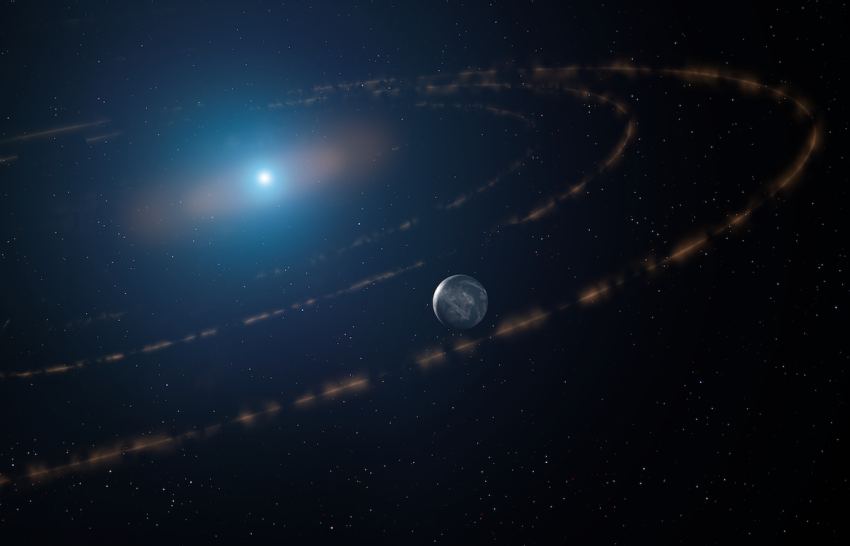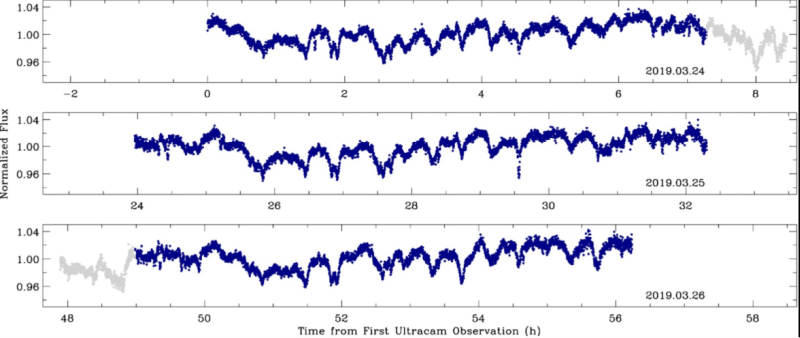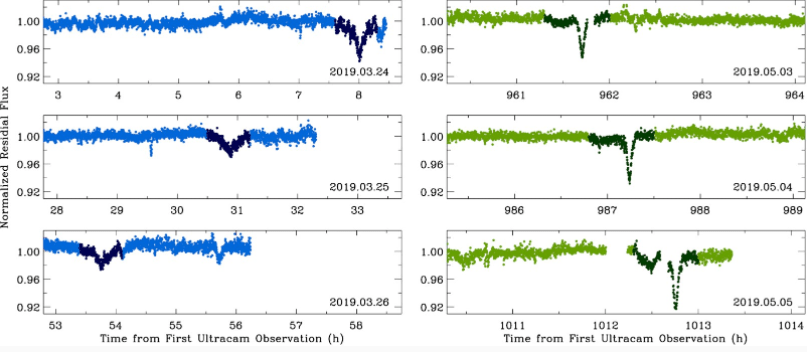Most stars will end their lives as white dwarfs. White dwarfs are the remnant cores of once-luminous stars like our Sun, but they've left their lives of fusion behind and no longer generate heat. They're destined to glow with only their residual energy for billions of years before they eventually fade to black.
Could life eke out an existence on a planet huddled up to one of these fading spectres?
For life to exist around a white dwarf, the white dwarf would have to have planets in its slowly shrinking habitable zone. Astronomers have found what appear to be planets in the habitable zone of a white dwarf about 117 light-years away. The planet might be nestled in a protoplanetary disk of debris.
A new study led by researchers from the University College of London announces the findings. The title is " Relentless and complex transits from a planetesimal debris disc. " It's published in the Monthly Notices of the Royal Astronomical Society, and the lead author is Professor Jay Farihi from the UCL Department of Physics & Astronomy.
“This is the first time astronomers have detected any kind of planetary body in the habitable zone of a white dwarf."Professor Jay Farihi, UCL Dep't. of Physics and Astronomy.
The star's name is WD1054–226. The researchers behind this work observed WD1054-226 for 18 nights with the ESO's New Technology Telescope (NTT) at their La Silla Observatory, observing dips in starlight as something passed between us and the star. They used the NTT's ULTRACAM high-speed camera to capture data images of the white dwarf. They also examined data on the same star from NASA's Transiting Exoplanet Survey Satellite (TESS.)
What were the results of those observations?
The team found dips in light that they interpret as 65 clouds of planetary debris. The clouds are evenly spaced and orbit the white dwarf every 25 hours. What causes such regularity? The researchers say that a planet must be there, which forces these debris clouds into a precise orbital pattern. They say the planet is similar in size to rocky planets in our Solar System and that it's only about 2.5 million km (1.55 million miles) from the star. That's about 1.7% of the distance between Earth and the Sun.
Alongside the regular dips in starlight is an ever-present obscuration that the team says is debris in a planetary disk around the star. These structures are in a region that would have been overcome when the white dwarf went through its preceding red giant phase. It's doubtful that any of these structures could have survived the red giant phase, so they must have formed more recently in the aftermath. If there is a planet in the habitable zone, it can't be a hold-over from the star's previous life as a main-sequence star. If all of the circumstances lined up just right—and that's an enormous if—life would potentially have about two billion years to do its thing on the purported planet, with one of those billions in the future.
"This is the first time astronomers have detected any kind of planetary body in the habitable zone of a white dwarf," said Professor Farihi. The planet's presence is inferred from the regular dips in the light of all the other objects in the system.
"An exciting possibility is that these bodies are kept in such an evenly-spaced orbital pattern because of the gravitational influence of a nearby major planet," Professor Farihi said in a press release. "Without this influence, friction and collisions would cause the structures to disperse, losing the precise regularity that is observed. A precedent for this 'shepherding' is the way the gravitational pull of moons around Neptune and Saturn helps to create stable ring structures orbiting these planets."
Not all of the team's observational data repeats with predictable regularity. The researchers also found at least two transient drifters in the data. "At least two drifting transits may be seen to recur over three or more nights," the team writes in their paper. The faster of the two has a period of about 22.9 hours, and the slower of the two has a period of about 25.5 hours.
There are indications of other drifters, but their data gets progressively weaker. The team explains this in their paper: "There are a number of dips that are either transient or cannot be confidently shown to recur, which are thus challenging to quantify. It is important to note that the process ... can only effectively remove recurring signals where multiple-night coverage is available at a given phase. Thus, some phases will suffer artifacts in this process, especially where coverage – either in the light curve or subtracted data – includes only a single night. Thus, not all light-curve residual structures are real." Such are the ways of astronomy.
The 65 separate structures the astronomers found could be moons or nascent moons. But if they are, they're nothing like the moons we're accustomed to. "The moon-sized structures we have observed are irregular and dusty (e.g. comet-like) rather than solid, spherical bodies. Their absolute regularity is a mystery we cannot currently explain," said lead author Farihi.
In their paper, the authors explain the 65 structures, saying that "There is no evidence for solid-body transits in any of the data, and the underlying transit sources are presumably relatively small but with extended comae of dust and gas." That's where their "comet-like" description comes from. "It cannot yet be determined what fraction of the stellar disc is constantly occluded, which could be significant," they write. "However, the duration of the transit events provides clear indications that the occulting clouds are non-spherical."
The data is intriguing, but the authors are the first to point out that any firm conclusions are premature. "The possibility of a major planet in the habitable zone is exciting and also unexpected; we were not looking for this. However, it is important to keep in mind that more evidence is necessary to confirm the presence of a planet. We cannot observe the planet directly, so confirmation may come by comparing computer models with further observations of the star and orbiting debris," Professor Farihi said.
If there are indeed clouds of material orbiting the white dwarf, they're likely outside the Roche limit. The authors say that debris clouds probably come from collisions or tidal disruption events. "From a dynamical and evolutionary perspective, the origin of the large occulting clouds is likely the result of tidal disruption or collisions in the vicinity of the Roche limit," they write in their conclusion.
It'll be up to further observations with the James Webb Space Telescope to provide better data. The JWST has the power to better define the debris disk and its components. But if there is a roughly Earth-sized rocky planet there, it's an intriguing possibility with liquid water potential.
Marginally habitable situations may be relatively common in the Milky Way and the Universe. Life might arise countless times and never evolve the complexity that life on Earth has become. The Moons of our Solar System might harbour life for some time. Mars may have harboured life for some time.
Now, maybe, we can add white dwarf planets to that list.
More:
- Press Release: Planetary bodies observed in habitable zone of dead star
- Published Research: Relentless and complex transits from a planetesimal debris disc
- Universe Today: White Dwarf Atmospheres Might Contain the Pulverized Crusts of Their Dead Planets
 Universe Today
Universe Today




